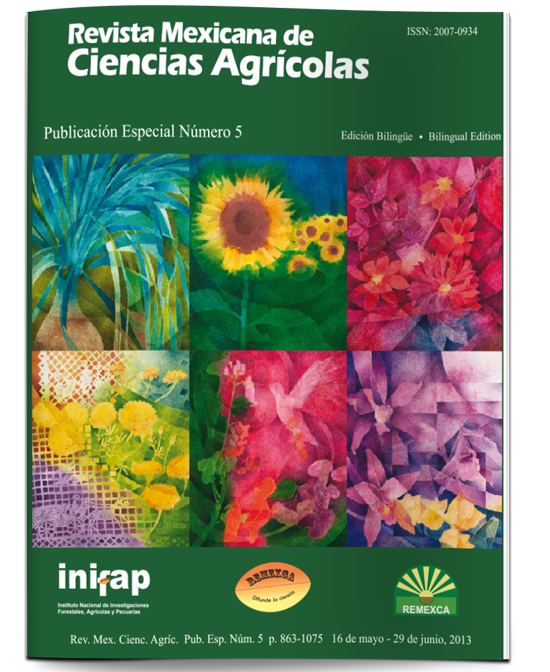Physical and chemical evaluation of volcanic rocks and its use for tulip production
DOI:
https://doi.org/10.29312/remexca.v0i5.1292Keywords:
Tulipa gesneriana L., foliar nutrient concentration, ornamental species, substrateAbstract
Physical and chemical characteristics of volcanic rocks were evaluated, using two particle sizes (3 and 5 mm) and its use in the production of tulip (Tulipa gesneriana) cv. Ille de France, taking as reference the commercial substrate ProMix®. The total porous space (67 and 67.9%), the easily water available (2.9 and 2.3%) and reserved water (1.9 and 1.1%) in the volcanic rocks (3 and 5 mm, respectively) were unsuitable for growing tulips. The pH was alkaline in the volcanic rocks and acid in ProMix®, in the latter the electrical conductivity was higher (1.46 dS m-1), but still within the limit set for substrates. N content was low in both materials (0.61% in volcanic rocks and 0.82% in ProMix®); Ca and Mg were higher in the volcanic rocks at 60 and 24.7%, respectively, on the contrary, in ProMix®, K was near three times higher than in the volcanic rocks. We found no Na in the volcanic rocks at all. In plants grown in 5 mm volcanic rocks the lowest foliar concentrations of K, Ca and Mg were found (11.08, 0.8 and 1.55 g kg-1, respectively). Foliar concentrations of N and P were not different between treatments. On the other hand, foliar concentrations of K and Ca in plants growing in 3 mm volcanic rocks were quite enough; while in the established ProMix® were excessive; and in 5 mm volcanic rocks were rather poor. Foliar concentration of Mg was low in plants established in volcanic rocks. We concluded that, the use of 3 mm volcanic rocks may be an alternative for the production of tulips, as long as the frequency of irrigation is reduced.
Downloads
Downloads
Published
How to Cite
Issue
Section
License
The authors who publish in Revista Mexicana de Ciencias Agrícolas accept the following conditions:
In accordance with copyright laws, Revista Mexicana de Ciencias Agrícolas recognizes and respects the authors’ moral right and ownership of property rights which will be transferred to the journal for dissemination in open access. Invariably, all the authors have to sign a letter of transfer of property rights and of originality of the article to Instituto Nacional de Investigaciones Forestales, Agrícolas y Pecuarias (INIFAP) [National Institute of Forestry, Agricultural and Livestock Research]. The author(s) must pay a fee for the reception of articles before proceeding to editorial review.
All the texts published by Revista Mexicana de Ciencias Agrícolas —with no exception— are distributed under a Creative Commons License Attribution-NonCommercial 4.0 International (CC BY-NC 4.0), which allows third parties to use the publication as long as the work’s authorship and its first publication in this journal are mentioned.
The author(s) can enter into independent and additional contractual agreements for the nonexclusive distribution of the version of the article published in Revista Mexicana de Ciencias Agrícolas (for example include it into an institutional repository or publish it in a book) as long as it is clearly and explicitly indicated that the work was published for the first time in Revista Mexicana de Ciencias Agrícolas.
For all the above, the authors shall send the Letter-transfer of Property Rights for the first publication duly filled in and signed by the author(s). This form must be sent as a PDF file to: revista_atm@yahoo.com.mx; cienciasagricola@inifap.gob.mx; remexca2017@gmail.
This work is licensed under a Creative Commons Attribution-Noncommercial 4.0 International license.



